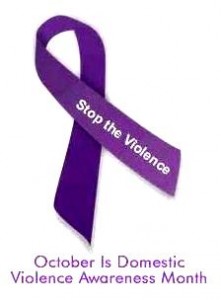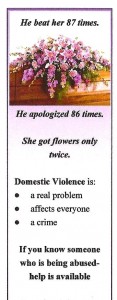I notice when I bring up domestic violence (DV), things go v-e-r-y quiet.
Yeah, I get that it’s an uncomfortable topic. We wouldn’t want to pry into people’s private business. Or insult a friend by revealing we suspect she’s being abused.
That’s sad—because DV is usually a family secret, and victims don’t talk about it  either. When the abuse finally becomes evident, someone often asks the victim why she never asked for help, never left. “I would have helped. Why didn’t you ever tell me?” The answer in one form or another is: “You never asked.”
either. When the abuse finally becomes evident, someone often asks the victim why she never asked for help, never left. “I would have helped. Why didn’t you ever tell me?” The answer in one form or another is: “You never asked.”
If victims won’t bring it up, and they’re never asked—How is help to arrive? Somebody has to be the first to speak the words. To ask a question. To offer an observation. To hold out hope. There are lives that need saving.
I guarantee, even if your friend doesn’t acknowledge the abuse to you when you discuss it, you will have planted a seed and alerted her to the fact she is not alone. Someone else cares. The abuse is not her fault. Life isn’t hopeless.
DV victims tend to be hyper-vigilant. They are watching. It’s a survival skill. So when one hears someone who seems to comprehend DV, she will know that when she’s ready, there is a safe person to talk with.
 So please, as October ends, don’t collude with the abuser and his coerced veil of silence. Get prepared. Plant a seed or two. Help families see fall as a time they can enjoy nature’s changing colors—and not hide the changing color of bruises.
So please, as October ends, don’t collude with the abuser and his coerced veil of silence. Get prepared. Plant a seed or two. Help families see fall as a time they can enjoy nature’s changing colors—and not hide the changing color of bruises.
I wonder why DV Awareness Month is October, but it seems apt. The colors of changing leaves—purple, green fading to yellow to brown—match the colors of bruising.
I promise you, I don’t beat the drum about DV every day. I won’t be posting on it every week. But come October, I feel an obligation to share information.
As you read this, does a friend come to mind? Perhaps she’s the one who needs to know a friend understands.
And thanks for reading this.



